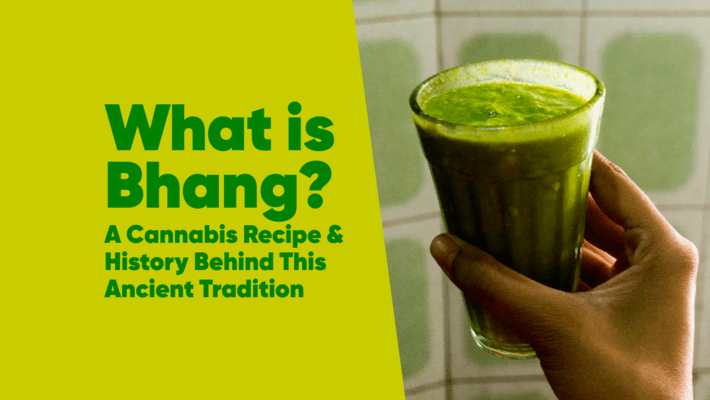
What is Bhang? A Cannabis Recipe and History Behind This Ancient Tradition
Published on 12/20/21
Marijuana has been around nearly as long as humanity has been walking the earth, and more specifically, cannabis use started back in Asia somewhere around 500 BC - and it wasn't all about just getting high, either. Cannabis goes a step further and holds very deep-rooted spiritual and medicinal purposes for many cultures all across the globe to this day. Below, we'll zero in on one culture's usage and look at the Hindu bhang tradition, examining its use and how to recreate one of the more ancient cannabis recipes.
What is Bhang?
 Unsplash
UnsplashBhang is an edible mixture made from the leaves, buds and flowers of the female marijuana plant that have been added to food and drinks for thousands of years in India. Making bhang includes grinding and soaking parts of the cannabis plant to make a paste, which is then used for edibles.
The History of Bhang
Bhang plays multiple roles in India, specifically for Hindu culture, which has been in practice for centuries. You'll find that not only is bhang used culturally for things such as festivals, rituals and religious traditions, but it is also used medicinally. Bhang is supposed to cure nausea, vomiting and physical pain. This should come as no surprise, as we know that today cannabis is still used to cure these exact bodily problems.
Bhang was also believed to cure fever and sunstroke while curing speech impediments and aiding digestion. Bhang was central to Ayurvedic medicine, which is a traditional Indian system of medicine, aiming to preserve health by keeping the mind, body and spirit in balance.
Bhang Use in Festivals & Rituals
 Unsplash
UnsplashWhile the therapeutic uses are abundant when it comes to this ancient form of edibles, bhang was likely used even more when it came to Hindu rituals and festivals. It has traditionally been distributed during the festival of Maha Shivaratri, which celebrates the Hindu god Shiva, who is believed to have used bhang to focus inward and harness his divine powers.
You'll also find bhang distributed at the very popular spring festival of Holi, the festival of love. The two go hand-in-hand these days, as this festival is a place where people let loose and relax with one of the most relaxing substances there is - cannabis. Bhang was also seen in Vedic rituals to overcome evil and enemies, citing cannabis as a "source of happiness."
The Legality of Bhang
When thinking about the legitimacy of this particular cannabis creation, it is a bit puzzling. Stated simply, cannabis is illegal in India, while bhang is entirely legal. How is this possible, you may ask? The answer here is that bhang has found a loophole. The 1985 Narcotic Drugs and Psychotropic Substances Act lists parts of the cannabis plant as a narcotic, such as the bud and resin. Conveniently, the leaves are left out, meaning that bhang is perfectly legal and typically sold during the above mentioned festivals.
Interestingly enough, when the British arrived to colonize, they conducted a study on the widespread use of cannabis called the Indian Hemp Drugs Commission Report of 1894 to see what the hype was all about. Experts conducted over one thousand interviews to gauge the social and moral impact of cannabis. The conclusion? Cannabis was deemed harmless, both socially & physically, which found prohibition unjustifiable. Maybe lawmakers today need to reference this when debating over the future of federal legalization.
How to Make Cannabis-Infused Drinks: Bhang Recipe

Cannabis tonics and seltzers, otherwise known as 420 drinks, are among the most popular ways to consume cannabis these days. If you're looking for a more traditional, less millennial form of cannabis-infused beverages and like incorporating marijuana in the kitchen, this recipe is for you!
Ingredients:
2 cups water
1/2-ounce marijuana (fresh leaves and flowers of a female plant)
4 cups warm milk
2 tablespoons blanched + chopped almonds
1/8 teaspoon garam masala (mixture of cloves, cinnamon and cardamon)
1/4 teaspoon powdered ginger
1/2 teaspoon rosewater
1 cup sugar
How to Make Bhang
- Bring the water to boil, remove any unwanted parts from the cannabis, add to the pot, and then cover. Let boil for about 7 minutes.
- Strain the water and cannabis through a muslin cloth, collect the water, and save it.
- Grab the leaves and flowers, squeeze and extract any liquid that remains. Add to water.
- Place leaves and flowers in mortar, add 2 teaspoons of milk. Grind together and then gather up the cannabis and squeeze out as much milk as you can. Repeat this until you have a 1/2 cup of milk.
- Collect this milk, place in a bowl.
- Add almonds and more warm milk. Grind in a mortar until there is a fine paste.
- Squeeze the paste and collect the extract like before.
- Combine all liquids that have been collected.
- Add the garam masala, ginger and rosewater. Also, add sugar and remaining milk.
- Chill and enjoy!
Other Variations to Bhang
 Unsplash
UnsplashFor a Bhang lassi, add 1/2 teaspoon of grenadine and a tablespoon of coconut milk. Common recipes also call for yogurt or curds for a traditional Indian lassi.
Another common variation is the thandai. It is a traditional, cold drink prepared with a plethora of ingredients such as almonds, fennel seeds, watermelon kernels, rose petals, pepper, poppy seeds and much more. Commonly associated with Maha Shivaratri and Holi as well, you'll grind this mixture into a paste, adding warm milk and the bhang mixture altogether. Bring to a simmer for 4-5 minutes, then let chill. Garnish with chia seeds and rose petals.
Have you tried this ancient cannabis cocktail? Do you have a favorite variation of the drink? Tell us in the comments below.
